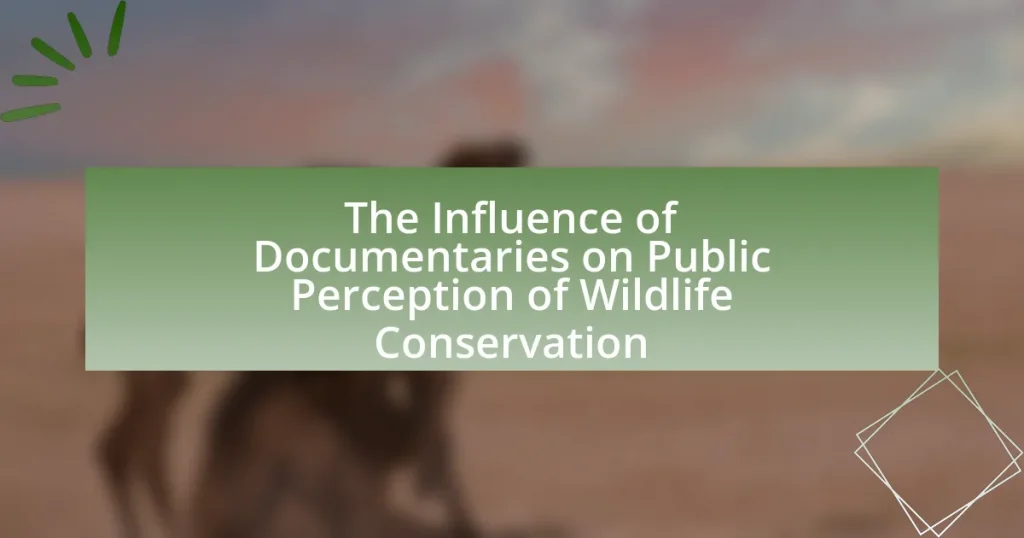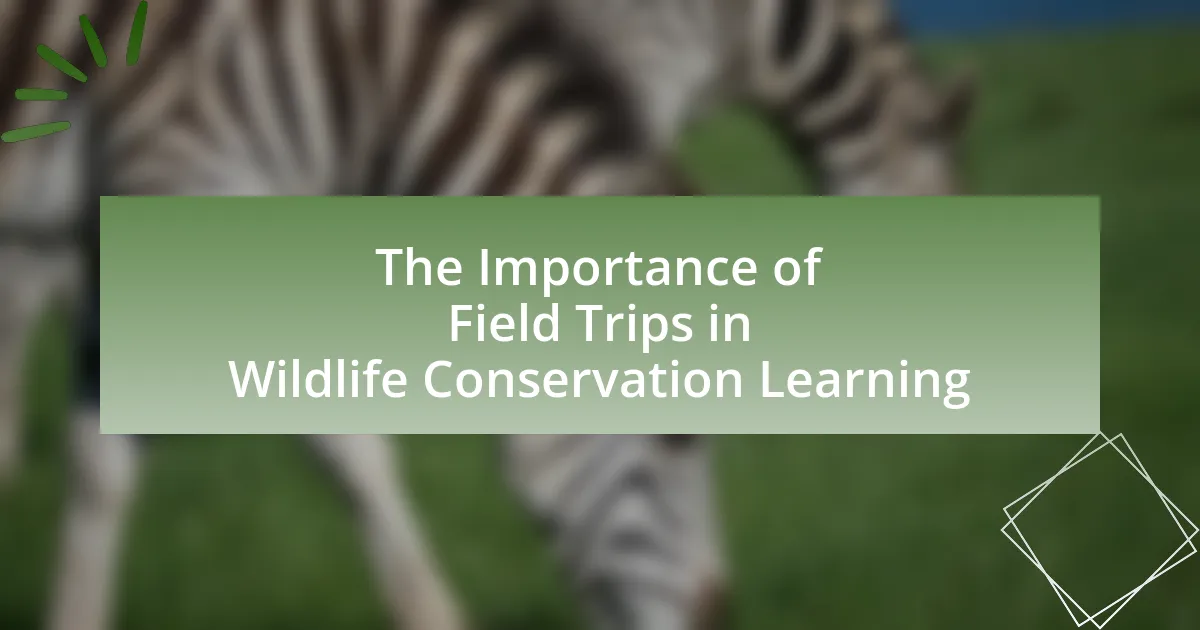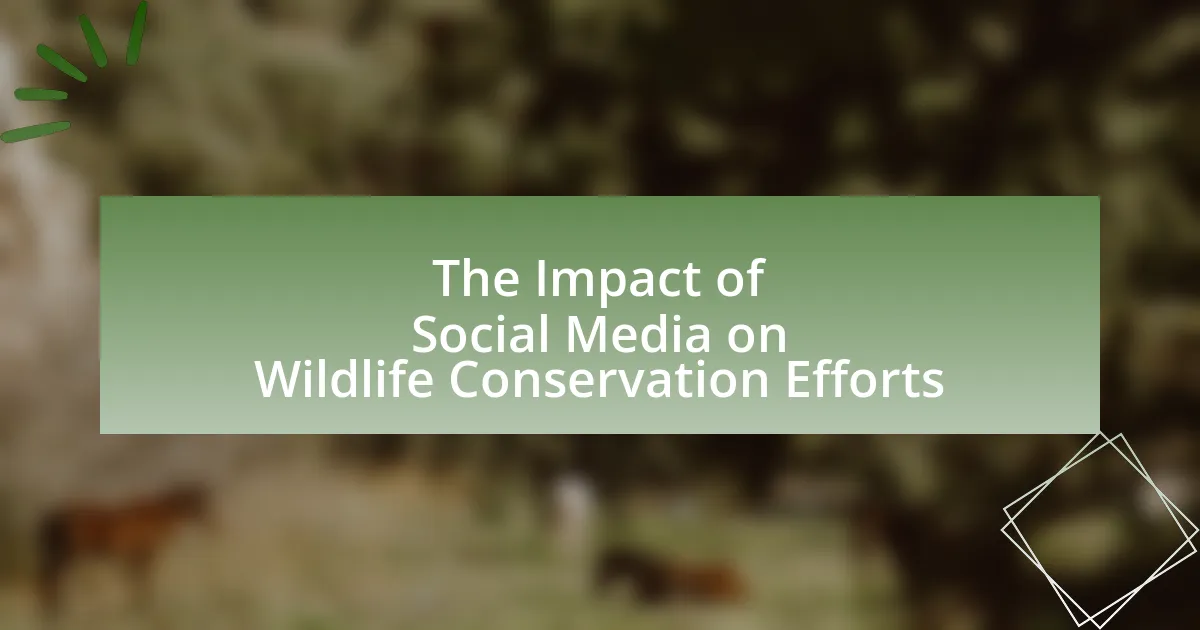The article examines the significant influence of documentaries on public perception of wildlife conservation. It highlights how films like “Our Planet” and “The Ivory Game” raise awareness about endangered species and biodiversity, leading to increased public support for conservation initiatives. Key elements such as narrative structure, emotional engagement, and factual accuracy are discussed, along with the impact of storytelling techniques on viewer attitudes. The article also explores the role of documentaries in educating the public, mobilizing grassroots movements, and influencing policy and funding for wildlife conservation efforts. Additionally, it addresses challenges such as misinformation and audience engagement that filmmakers face in effectively conveying conservation messages.
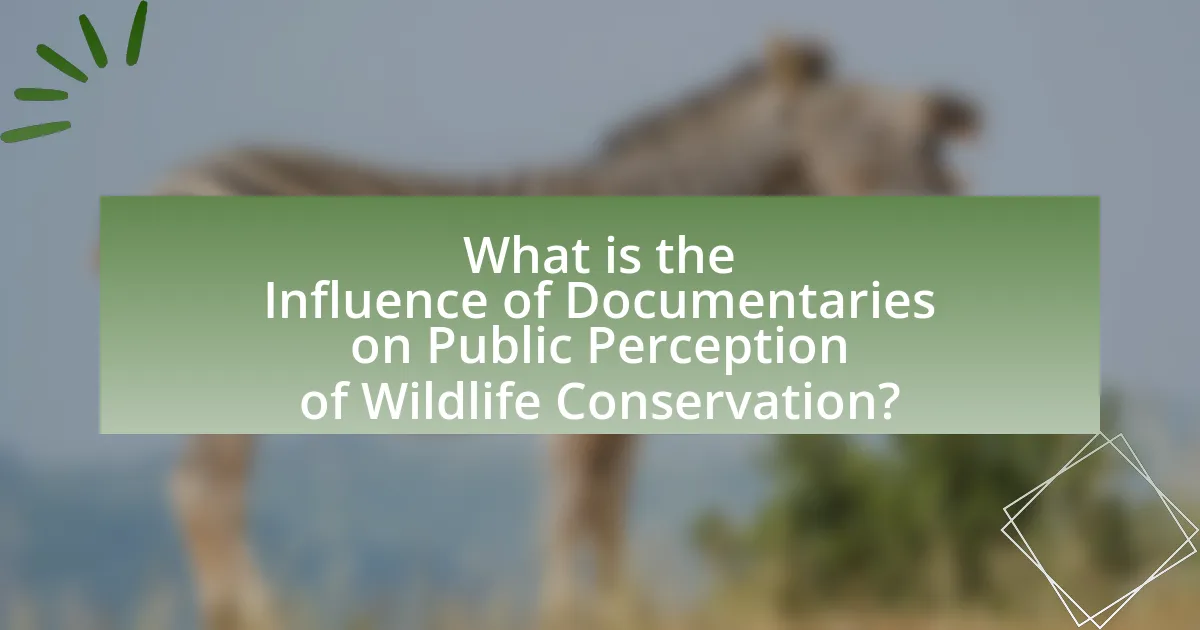
What is the Influence of Documentaries on Public Perception of Wildlife Conservation?
Documentaries significantly influence public perception of wildlife conservation by raising awareness and fostering emotional connections to environmental issues. Research indicates that documentaries, such as “Our Planet” and “The Ivory Game,” effectively highlight the plight of endangered species and the importance of biodiversity, leading to increased public support for conservation initiatives. A study published in the journal “Conservation Biology” found that viewers of wildlife documentaries reported a greater understanding of conservation challenges and a higher likelihood of engaging in pro-conservation behaviors, such as donating to wildlife organizations or participating in conservation activities. This demonstrates that documentaries serve as powerful tools for educating the public and motivating action towards wildlife conservation.
How do documentaries shape public understanding of wildlife conservation?
Documentaries shape public understanding of wildlife conservation by providing visual narratives that highlight the importance of biodiversity and the threats faced by various species. These films often present compelling stories that evoke emotional responses, making complex ecological issues more relatable and understandable to a broad audience. For instance, the documentary “Our Planet,” narrated by David Attenborough, showcases the impact of climate change on wildlife, effectively raising awareness and prompting discussions about conservation efforts. Research indicates that viewers of wildlife documentaries are more likely to support conservation initiatives, as evidenced by a study published in the journal “Conservation Biology,” which found that exposure to such media significantly increased public engagement and advocacy for wildlife protection.
What are the key elements of documentaries that impact viewer perception?
The key elements of documentaries that impact viewer perception include narrative structure, visual storytelling, emotional engagement, and factual accuracy. Narrative structure guides the viewer’s understanding and emotional journey, while visual storytelling employs imagery and cinematography to evoke feelings and highlight critical issues. Emotional engagement is crucial, as it fosters a connection between the audience and the subject matter, often leading to increased empathy and concern. Factual accuracy ensures credibility, as viewers are more likely to trust and be influenced by documentaries that present verified information. For instance, a study by the University of California found that documentaries with strong emotional narratives significantly increased viewers’ willingness to support wildlife conservation initiatives.
How do storytelling techniques in documentaries affect emotional engagement?
Storytelling techniques in documentaries significantly enhance emotional engagement by creating relatable narratives that resonate with viewers. Techniques such as character development, personal anecdotes, and immersive visuals draw audiences into the subject matter, fostering empathy and connection. For instance, a documentary that follows the life of a specific animal can evoke compassion by showcasing its struggles and triumphs, making the audience more invested in its fate. Research indicates that emotional storytelling can increase viewer retention and motivate action; a study published in the Journal of Environmental Psychology found that narratives that evoke strong emotions lead to higher levels of concern for wildlife conservation issues. Thus, effective storytelling in documentaries not only captivates viewers but also influences their attitudes and behaviors towards wildlife conservation.
Why are documentaries important for wildlife conservation awareness?
Documentaries are important for wildlife conservation awareness because they effectively educate and engage the public about environmental issues and species at risk. By showcasing the beauty and complexity of wildlife, documentaries evoke emotional responses that can inspire viewers to take action. For instance, the documentary “Our Planet,” narrated by David Attenborough, highlights the impact of climate change on various ecosystems, leading to increased public discourse and support for conservation initiatives. Research indicates that visual storytelling can significantly enhance understanding and retention of information, making documentaries a powerful tool for raising awareness and fostering a sense of responsibility towards wildlife conservation.
What role do documentaries play in educating the public about endangered species?
Documentaries play a crucial role in educating the public about endangered species by providing visual narratives that highlight the plight of these animals and the ecosystems they inhabit. Through compelling storytelling and factual information, documentaries raise awareness about the threats faced by endangered species, such as habitat loss, poaching, and climate change. For instance, the documentary “Our Planet,” narrated by David Attenborough, showcases the impact of human activity on wildlife and emphasizes the urgency of conservation efforts. This type of media not only informs viewers but also evokes emotional responses, motivating individuals to engage in conservation actions and support policies aimed at protecting endangered species.
How do documentaries influence public attitudes towards conservation efforts?
Documentaries significantly influence public attitudes towards conservation efforts by raising awareness and fostering emotional connections to environmental issues. Through compelling storytelling and visual imagery, documentaries like “Our Planet” and “Chasing Ice” highlight the urgency of conservation, often leading to increased public support for environmental policies. Research indicates that viewers of nature documentaries are more likely to engage in pro-environmental behaviors, as evidenced by a study published in the journal “Conservation Biology,” which found that exposure to conservation-themed media can enhance knowledge and concern for biodiversity. This demonstrates that documentaries serve as powerful tools in shaping public perception and motivating action towards conservation initiatives.
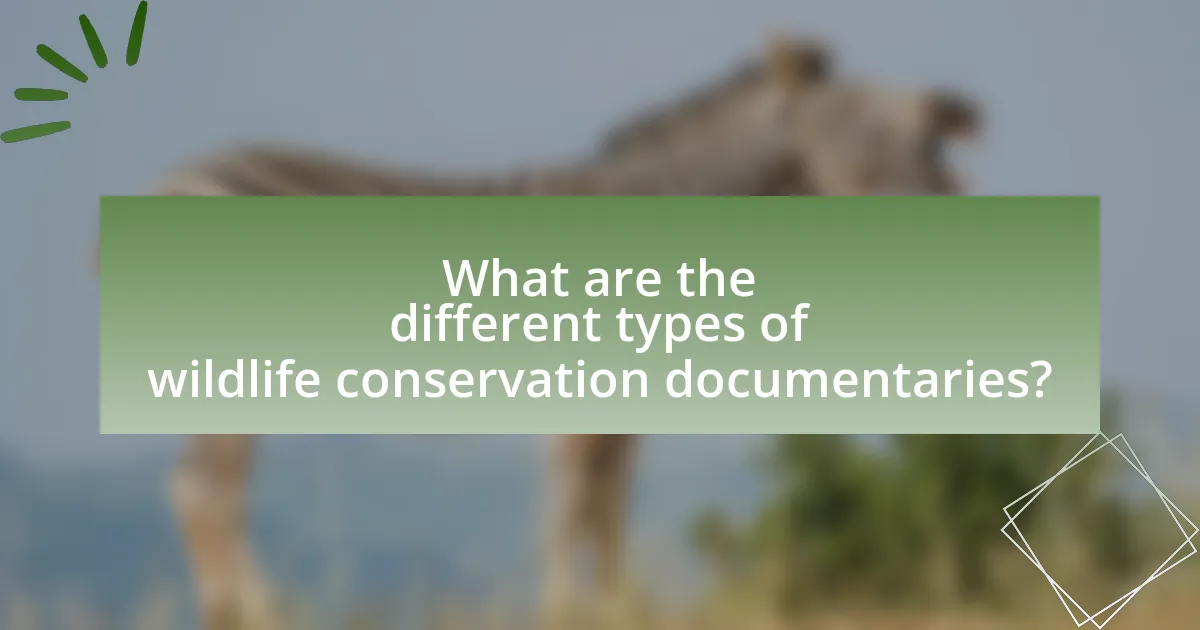
What are the different types of wildlife conservation documentaries?
Wildlife conservation documentaries can be categorized into several types, including observational, expository, participatory, and poetic documentaries. Observational documentaries focus on capturing wildlife in their natural habitats without interference, allowing viewers to witness behaviors and interactions authentically. Expository documentaries aim to inform and educate the audience about specific conservation issues, often using narration and expert interviews to present facts and statistics. Participatory documentaries involve the filmmaker actively engaging with the subjects, often highlighting the efforts of conservationists and local communities. Poetic documentaries emphasize visual storytelling and emotional resonance, using artistic techniques to evoke feelings about wildlife and conservation challenges. Each type plays a significant role in shaping public perception and awareness of wildlife conservation issues.
How do nature documentaries differ from conservation-focused films?
Nature documentaries primarily aim to showcase the beauty and diversity of wildlife and natural environments, while conservation-focused films specifically emphasize the importance of protecting these ecosystems and the threats they face. Nature documentaries often highlight animal behavior and habitats, aiming to educate and entertain viewers about the natural world, whereas conservation films advocate for specific actions or policies to address environmental issues, often featuring calls to action or highlighting the impact of human activities on wildlife. For instance, a nature documentary may explore the life cycle of a particular species, while a conservation film might focus on the decline of that species due to habitat loss and climate change, urging viewers to support conservation efforts.
What themes are commonly explored in wildlife conservation documentaries?
Wildlife conservation documentaries commonly explore themes such as biodiversity, habitat preservation, human-wildlife conflict, and the impact of climate change on ecosystems. These themes highlight the importance of protecting various species and their habitats, illustrating the interconnectedness of life on Earth. For instance, documentaries often showcase specific endangered species, emphasizing the urgent need for conservation efforts to prevent extinction. Additionally, they frequently address the consequences of human activities, such as deforestation and pollution, on wildlife populations and their habitats. By presenting these themes, documentaries aim to raise awareness and inspire action among viewers, ultimately influencing public perception and support for wildlife conservation initiatives.
How do different formats (e.g., series vs. feature films) impact viewer engagement?
Different formats, such as series and feature films, significantly impact viewer engagement by influencing the depth of storytelling and emotional connection. Series allow for extended character development and complex narratives, which can lead to higher viewer investment over time; for example, a study by the University of Southern California found that serialized storytelling can increase audience retention by up to 30% compared to standalone films. In contrast, feature films often deliver a concise, impactful message within a limited timeframe, which can create a strong immediate emotional response but may lack the depth of engagement found in series. Thus, the format chosen can shape how effectively a documentary communicates its themes and resonates with the audience, ultimately affecting public perception of issues like wildlife conservation.
What are some notable examples of impactful wildlife conservation documentaries?
Notable examples of impactful wildlife conservation documentaries include “The Ivory Game,” “Our Planet,” and “Chasing Ice.” “The Ivory Game” exposes the illegal ivory trade and its devastating effects on elephant populations, highlighting the urgency of conservation efforts. “Our Planet,” narrated by David Attenborough, showcases the beauty of the natural world while addressing the threats posed by climate change, influencing public awareness and action. “Chasing Ice” documents the melting glaciers due to climate change, providing visual evidence of environmental shifts that underscore the need for conservation. Each of these documentaries has significantly raised awareness and prompted discussions on wildlife conservation issues.
How did “Our Planet” change perceptions of global biodiversity?
“Our Planet” significantly changed perceptions of global biodiversity by showcasing the intricate relationships within ecosystems and the urgent threats posed by climate change and human activity. The documentary employed stunning visuals and compelling narratives to highlight the beauty and fragility of nature, making the concept of biodiversity more relatable and urgent for viewers. For instance, it illustrated the decline of species and habitats, emphasizing that biodiversity loss directly impacts human survival and well-being. This approach has been supported by research indicating that visual storytelling can enhance emotional engagement and awareness, leading to increased public concern and advocacy for conservation efforts.
What lessons can be learned from “The Ivory Game” regarding poaching awareness?
“The Ivory Game” teaches that raising awareness about poaching is crucial for wildlife conservation. The documentary highlights the devastating impact of the ivory trade on elephant populations, revealing that approximately 20,000 elephants are killed annually for their tusks. It emphasizes the importance of educating the public about the consequences of poaching and the illegal wildlife trade, showcasing how informed consumers can influence demand for ivory products. Additionally, the film illustrates the role of grassroots activism and international cooperation in combating poaching, demonstrating that collective action can lead to significant changes in policy and public attitudes towards wildlife protection.
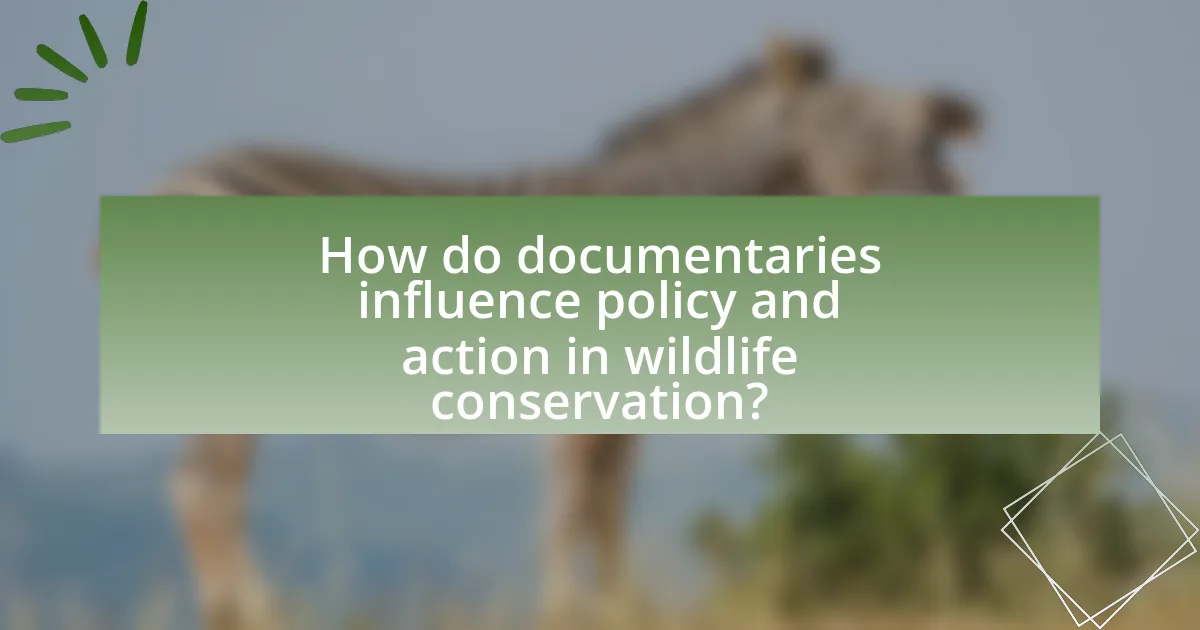
How do documentaries influence policy and action in wildlife conservation?
Documentaries influence policy and action in wildlife conservation by raising public awareness and generating emotional engagement with conservation issues. For instance, the documentary “The Cove” significantly impacted public perception of dolphin hunting in Japan, leading to increased activism and pressure on policymakers to address the issue. Research indicates that documentaries can shift public attitudes, as evidenced by a study published in the journal “Conservation Biology,” which found that viewers of wildlife documentaries were more likely to support conservation initiatives and policies. This heightened awareness often translates into advocacy efforts, prompting legislative changes and funding for conservation projects.
What evidence exists that documentaries lead to increased conservation funding?
Documentaries have been shown to lead to increased conservation funding through various studies and specific instances. For example, the documentary “The Cove” significantly raised awareness about dolphin hunting in Japan, resulting in a reported increase in donations to marine conservation organizations by over 50% following its release. Additionally, research published in the journal “Conservation Biology” indicates that documentaries can enhance public engagement and financial support for conservation initiatives, with a survey revealing that 70% of viewers felt motivated to contribute to conservation efforts after watching impactful wildlife documentaries. These examples illustrate a clear correlation between documentary viewership and increased funding for conservation projects.
How do documentaries mobilize grassroots movements for wildlife protection?
Documentaries mobilize grassroots movements for wildlife protection by raising awareness and inspiring action through compelling storytelling and visual evidence. These films often highlight the plight of endangered species and the impact of human activities on ecosystems, effectively engaging viewers emotionally and intellectually. For instance, the documentary “The Ivory Game” illustrates the illegal ivory trade’s devastating effects on elephant populations, prompting viewers to support conservation initiatives and advocacy groups. Research indicates that documentaries can significantly increase public engagement, with studies showing that viewers are more likely to participate in conservation efforts after watching impactful films. This combination of emotional resonance and factual information drives grassroots mobilization, leading to increased activism and support for wildlife protection initiatives.
What challenges do wildlife conservation documentaries face in influencing public perception?
Wildlife conservation documentaries face significant challenges in influencing public perception, primarily due to issues of audience engagement and misinformation. Audience engagement is hindered by the oversaturation of content, leading to viewer fatigue and desensitization to conservation messages. For instance, a study published in the journal “Conservation Biology” found that repeated exposure to similar themes can diminish emotional impact, making it harder for documentaries to resonate with viewers. Additionally, misinformation proliferates through social media and other platforms, complicating the narrative presented in documentaries. Research from the Pew Research Center indicates that 64% of Americans believe misinformation is a major problem in society, which can undermine the credibility of conservation efforts depicted in documentaries. These factors collectively impede the ability of wildlife conservation documentaries to effectively shape public perception and drive action.
How do misinformation and sensationalism in media affect documentary credibility?
Misinformation and sensationalism in media significantly undermine documentary credibility by distorting facts and exaggerating narratives. Documentaries rely on factual accuracy and balanced storytelling to build trust with audiences; when these elements are compromised, viewers may question the authenticity of the content. For instance, a study published in the journal “Media, Culture & Society” found that sensationalized portrayals of wildlife can lead to misconceptions about species behavior and conservation needs, ultimately affecting public support for conservation efforts. This erosion of trust can result in decreased engagement with important environmental issues, as audiences become skeptical of the information presented in documentaries.
What barriers exist in reaching diverse audiences with conservation messages?
Barriers in reaching diverse audiences with conservation messages include cultural differences, language barriers, and varying levels of access to information. Cultural differences can lead to misunderstandings or disinterest in conservation topics that do not resonate with specific communities. Language barriers hinder effective communication, making it difficult for non-native speakers to engage with conservation messages. Additionally, varying levels of access to information, influenced by socioeconomic factors, can limit exposure to conservation initiatives, particularly in underserved communities. These barriers collectively impede the effectiveness of conservation messaging across diverse populations.
What practical steps can filmmakers take to enhance the impact of wildlife conservation documentaries?
Filmmakers can enhance the impact of wildlife conservation documentaries by incorporating compelling storytelling techniques, utilizing high-quality visuals, and engaging with local communities. Compelling storytelling captivates audiences and fosters emotional connections, which can lead to increased awareness and action. High-quality visuals, such as stunning cinematography and immersive sound design, can effectively showcase the beauty and urgency of wildlife conservation issues, making the content more engaging and shareable. Engaging with local communities ensures authentic representation and can provide valuable insights into conservation efforts, thereby enhancing credibility and relatability. Research indicates that documentaries that effectively combine these elements can significantly influence public perception and motivate viewers to support conservation initiatives.
How can filmmakers effectively engage audiences through social media platforms?
Filmmakers can effectively engage audiences through social media platforms by creating interactive content that encourages audience participation. This includes utilizing polls, Q&A sessions, and live streaming events to foster a sense of community and involvement. Research indicates that interactive posts generate 50% more engagement than static content, highlighting the importance of audience interaction in building a loyal following. Additionally, sharing behind-the-scenes footage and personal stories related to wildlife conservation can humanize the filmmakers and create emotional connections with viewers, further enhancing engagement.
What strategies can be employed to ensure accurate representation of wildlife issues?
To ensure accurate representation of wildlife issues, employing evidence-based storytelling is essential. This strategy involves using scientifically validated data and expert testimonials to depict wildlife accurately, thereby fostering informed public perception. For instance, documentaries that incorporate research from organizations like the World Wildlife Fund or the International Union for Conservation of Nature provide credible insights into species behavior and conservation needs. Additionally, collaborating with wildlife biologists and conservationists during the production process enhances the authenticity of the narrative, ensuring that the complexities of wildlife issues are conveyed accurately. This approach not only educates viewers but also promotes a deeper understanding of the ecological challenges faced by wildlife, ultimately influencing public attitudes towards conservation efforts.
